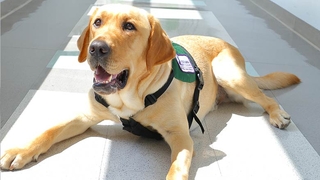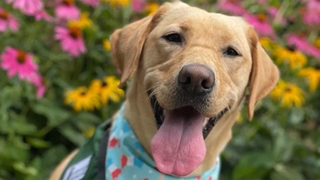CHOP Facility Dog Program

When a patient needs a little extra support, they may benefit from a visit from a CHOP facility dog who can support patients with goal-oriented interventions.
These specially trained dogs work with Child Life staff members to help patients and families during hospitalization. The CHOP Facility Dog Program is a donor-funded program, and services are not billable to insurance.
How facility dogs can help
A facility dog can:
- Motivate patients to move or ambulate after surgery
- Demonstrate medication administration
- Help with pain management
- Comfort patients and families facing a chronic or life-changing illness
- Help patients cope with the stress of hospitalization by providing opportunities for therapeutic expression
Meet our facility dogs

Hi, I’m Dilly!
I’m a: yellow Labrador.
I was trained by: Susquehanna Service Dogs.
My handler is: Child Life Specialist, Lizzy Olsen.
My favorite part of being a facility dog is: helping patients and families cope with new experiences while in the hospital.
Favorite hobby: Snuggling and sleeping.

Hi, I’m Nettle!
I’m a: yellow Labrador, too!
I was trained by: Susquehanna Service Dogs.
My handler is: Child Activity Coordinator, Danielle Stewart.
My favorite part of being a facility dog is: getting to interact with CHOP’s brave and strong patients.
Favorite hobby: Belly rubs and playing fetch!
Eligibility
To be eligible for a visit from a CHOP facility dog, patients must be:
- Free from pet allergies
- Having difficulty coping with hospitalization
- Hospitalized for at least 3 days, with no anticipated discharge within the next 24 hours
Due to our Infection Prevention and Control standards, a patient is not eligible for a facility dog visit if they or their roommate are on contact isolation/precautions.
Request a visit
Requests for a visit from a facility dog are submitted by the patient’s primary child life specialist or bedside nurse.